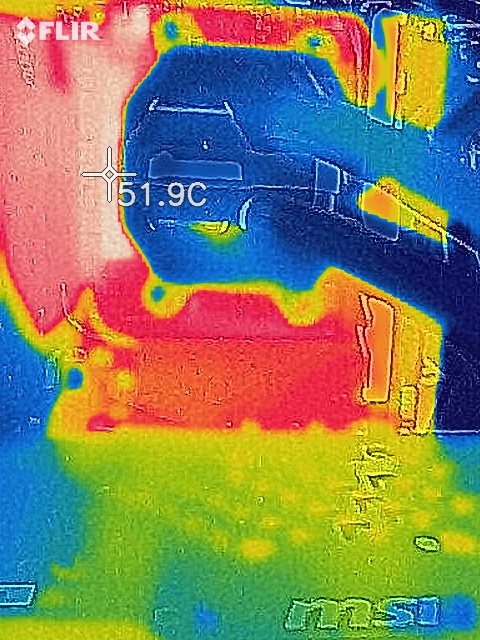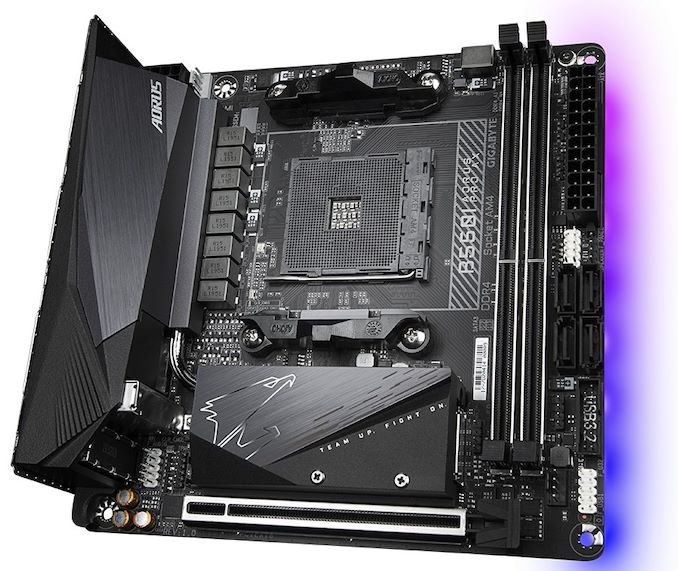The GIGABYTE B550I Aorus Pro AX Motherboard Review: All The Small Things
by Gavin Bonshor on December 7, 2020 10:00 AM EST_678x452.jpg)
Sometimes less is more, and when it comes to motherboards the mini-ITX form factor has some of the most enthusiastic fan club members. Small form factor systems are becoming more widely used as we're ushered into a single graphics card setup dominated landscape. and in terms of features to price, the B550 chipset has some of the most cost-effective of any current desktop platform. One such board is the GIGABYTE B550I Aorus Pro AX which combines a wave of premium features combined with AMD's B550 chipset. It includes compatibility for PCIe 4.0 devices with supported processors, dual PCIe M.2 slots, and 2.5 gigabit Ethernet. It's time to give our verdict on it and see if it can cut it in a very competitive small is more market.
GIGABYTE B550I Aorus Pro AX Overview
One of GIGABYTE's most scalable ranges is its Aorus series, which typically aims its feature set and aesthetics at gamers. Often clad in RGB enabled heatsinks and componentry, the Aorus series is now GIGABYTE's most widely recognizable range, which stretches from the larger E-ATX to small-sized mini-ITX offerings in motherboards, but also covers graphics cards, laptops, and all manner of other components.
Focusing on the mini-ITX form factor, the range on offer is considerably more competitive than the ATX market for a couple of reasons. The first is that there are much fewer small form factor models available, meaning manufacturers are limited in what they can do and need to strive to get the right solution, sometimes at the first time of asking. The second is that with less to choose from, it's key in getting a model that fits the desired feature set and for the rest of the hardware to fit the whole aspect of a system build.
Less is more in some cases, but fewer PCIe slots available means less room for the addition of controllers such as networking, storage, and other devices. Focusing primarily on what the GIGABYTE B550I Aorus Pro AX has to offer, it blends subtle black and grey tones for an elegant look, with the board's integrated RGB located along the right-hand side of the board for a rainbow infused under glow effect. While having a look that should fit into most systems in terms of aesthetics, the mini-ITX Aorus Pro AX has plenty of features. This includes a PCIe 4.0 x4 M.2 slot located on the front and a PCIe 3.0 x4/SATA M.2 slot on the rear, with four SATA ports, and two memory slots capable of support up to DDR4-5100 memory, with a total capacity of 64 GB. Looking at networking, it uses a premium 2.5 GbE controller with a Wi-Fi 6 interface pairing. Simultaneously, the onboard audio solution is also good, which one expects from a mid-range model.
Putting the GIGABYTE through our testing suite, the B550I Aorus Pro AX performed well in the majority of our system tests, with good showings in all three power tests, as well as in our POST time testing. DPC latency performance was average at best, and it performed competitively when compared to other AM4 based models tested with our Ryzen 7 3700X processor in our CPU and gaming tests.

The GIGABYTE B550I Aorus Pro AX undergoing thermal VRM testing
In our overclock testing, the Aorus Pro AX performed as expected, with its premium 8-phase power delivery consisting of six 90 A power stages for the CPU VCore, and two 90 A power stages for the SoC. We saw good VDroop control under load, with consistent performance increases in our testing as we ran each frequency. Even under full-load with lots of CPU VCore to stress the power delivery, it performed very well for a mini-ITX sized model, with competitive temperatures when compared to other AM4 models.
The GIGABYTE B550I Aorus Pro AX plays to the strengths of the X570 chipset, as a B550 mini-ITX board can only include so much, so it benefits from the small form factor with full PCIe 4.0 support as opposed to an ATX sized variant. At present, the B550I Aorus Pro AX is available at Amazon for $179, which is a little cheaper than MSI's MPG B550I Gaming Edge WiFi model at $185, and ASRock's B550 Phantom Gaming-ITX/AX at $200. All three of these models, including similar feature sets, including premium integrated audio, 2.5 GbE networking, and Wi-Fi 6 capabilities. The end decision could come down to performance, memory compatibility, and other aspects such as power delivery, rear panel I/O connectivity, which all three models include respectable offerings, but for GIGABYTE's model, it's time to see how it stacks up against other model's we've tested.
Read on for our extended analysis and comparison tests.











76 Comments
View All Comments
Grabo - Tuesday, December 8, 2020 - link
I've had this board since summer, currently on the latest firmware. No complaints, except the disappearing bluetooth. Sometimes it's there, mostly it isn't. Dual booting linux and windows and it's the same in both. I acquired a usb bluetooth adapter as soon as I read about others having the same issue with this board.mkarwin - Tuesday, December 15, 2020 - link
Seems like using the BT for key/mouse wireless device is out of the question in this case then?R3MF - Tuesday, December 8, 2020 - link
I have this board, been great.Fujikoma - Tuesday, December 8, 2020 - link
The owner's guide is pretty skimpy. There were no instructions or visuals for installation of the NVME drives, which I found very odd because the top side spacer screw threw me for a moment. It may seem dumb, but I'm a stickler for reading instructions before installing even simple things. Very much enjoyed seeing this article, since I bought this board for my wife to use for lite gaming.Dug - Tuesday, December 8, 2020 - link
For the love of everything motherboards, please go back to or start testing the components on the motherboard. Wifi, ethernet, sound, memory, storage of m.2 front and back, sata, bluetooth, USB. These are the things that make or break a consumer buying a motherboard.All the testing you do, just says it runs some benchmarks. That's great, but unless a motherboard fails (I haven't seen a review yet that a motherboard fails to run your tests), then it's not really helping us.
How about clearance for popular heatsinks.
And why do you insist on measuring non uefi boot times? It's a waste of your time and everyone else.
Gigaplex - Tuesday, December 8, 2020 - link
Fair comment, I did have some clearance issues with this board for heatsinks. Even the stock Wraith Stealth needed the plastic shroud to be rotated 90 degrees to fit on this board.Gigaplex - Tuesday, December 8, 2020 - link
This is a weird time to post a review like this for this board. It has been out for a while, and has been solid for most of that time. However with the Zen 3 enablement BIOSes, there's been a lot of issues.6YearsLater - Tuesday, December 8, 2020 - link
Why didn't anandtech do graphis card reviews?biatch0 - Wednesday, December 9, 2020 - link
I recently got this exact board and am happy with it overall - other than the Bluetooth requiring a complete power off and disconnect from PSU in order to work regularly... but apparently that's a B550 issue?Grabo - Wednesday, December 9, 2020 - link
That may indeed be the case, am reading about the same issue for several brand B550 boards now. Back when I got this board in the summer I only found references to it. But yes, there was the unplug psu and replug advice then too, which does always work, but it isn't very handy when the psu is built into the chassis (nr200)..so I got an aptx usb bt adapter which always shows up. Software wise one just needs to handle the ax200 bt when it does randomly decide to show up (which it does sometimes, even if you don't unplug the psu).